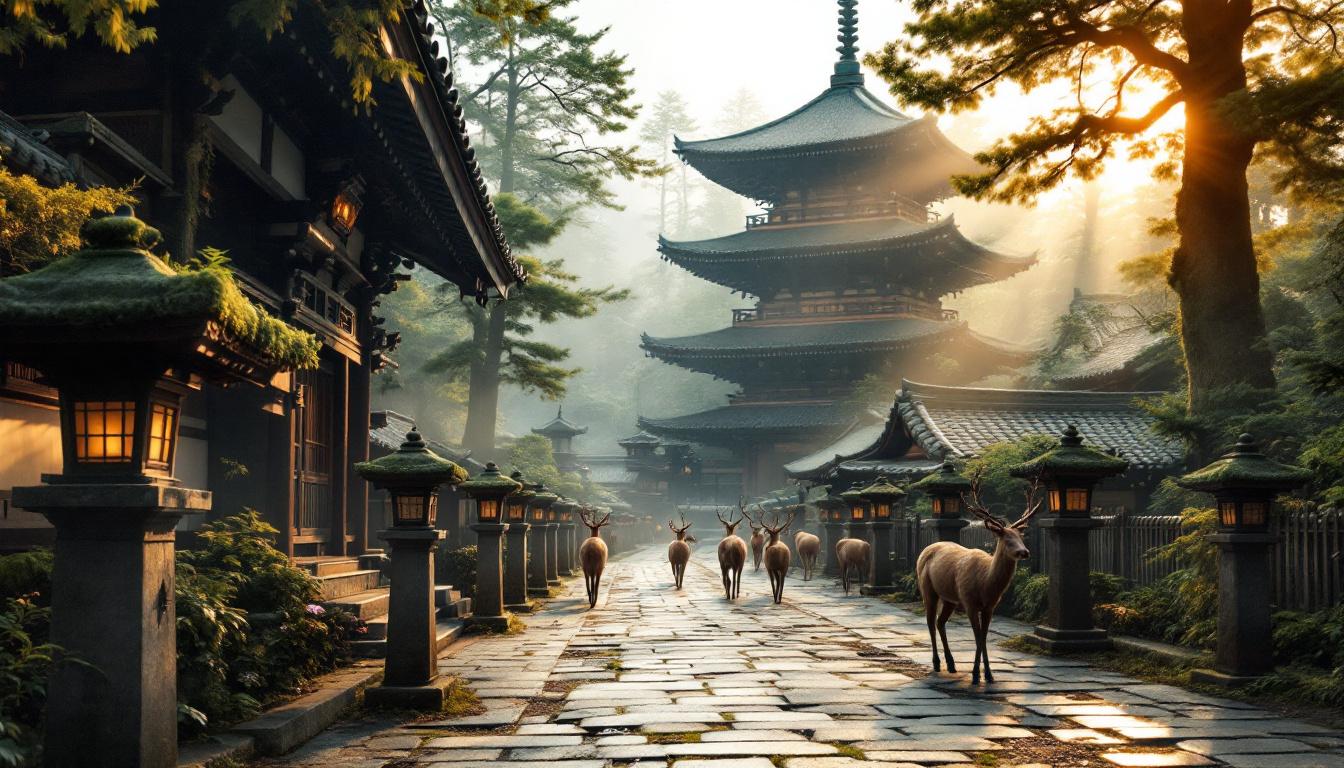Walking through Nara’s narrow cobblestone streets feels like stepping into a medieval European village, complete with ancient architecture and mysterious pathways. But this Japanese city holds secrets far older than any European cathedral.
Where medieval Europe has Gothic spires, Nara showcases elegant pagodas rising through ancient forests. The sacred deer wandering freely between 1,300-year-old temples create an atmosphere that’s simultaneously familiar and utterly unique.
This ancient capital predates most European medieval cities by centuries, yet maintains an intimate village charm that makes every corner feel like a personal discovery.
The architectural illusion that captivates European visitors
Medieval monastery layouts with Buddhist temples
Nara’s Tōdai-ji complex mirrors European monastery towns with its ceremonial courtyards and processional pathways. The world’s largest wooden building measures 57m × 50m, rivaling Notre-Dame Cathedral in scale while housing a 14.98-meter seated bronze Buddha that dwarfs any European religious statue.
Stone-lined paths reminiscent of ancient villages
Kasuga-taisha’s 3,000 stone lanterns create labyrinthine pathways that echo medieval European pilgrimage routes. These moss-covered trails wind through a primeval cedar forest that has remained untouched for over 1,000 years, offering visitors a mystical journey through living history.
What makes this more authentic than European medieval towns
Sacred deer roaming freely through historic streets
Over 1,200 sacred deer wander Nara Park as they have since 768 CE, protected by ancient Shinto beliefs that consider them divine messengers. Unlike European wildlife kept in reserves, these deer bow for treats and interact directly with visitors in the heart of the historic district.
Temples that predate European cathedrals by centuries
While Europe’s grandest cathedrals were built around 1200 CE, Nara’s Tōdai-ji was founded in 738 CE. The original wooden structures have survived earthquakes, fires, and wars through traditional Japanese craftsmanship that European stone buildings couldn’t match.
The summer temple forest experience European cities can’t offer
Natural cooling in ancient sacred groves
July temperatures reach 34°C in the city, but Kasugayama’s primeval forest provides 5°C cooler refuge beneath thousand-year-old cedars. This UNESCO-protected ecosystem adjoins urban temples, creating a unique microclimate that medieval European cities lack.
Evening lantern festivals that illuminate history
The Nara Tokae festival transforms temples into ethereal wonderlands with thousands of illuminated lanterns each July. Unlike European Christmas markets, this ancient tradition uses traditional craftsmanship to create spiritual ambiance that connects visitors directly with Shinto practices.
Local secrets that preserve authentic medieval atmosphere
Traditional crafts still practiced by master artisans
Local artisans continue creating Nara-zuke pickles and handmade sumi ink brushes using techniques unchanged for centuries. These craftspeople work in historic districts where traditional wooden architecture creates an authentic medieval atmosphere without tourist commercialization.
Proper deer interaction etiquette locals protect
Residents teach visitors to bow before feeding deer and use only official shika senbei crackers. This respectful interaction preserves the sacred relationship between humans and animals that has defined Nara’s spiritual character since the 8th century.
Nara offers something medieval Europe never could: a living connection to an even more ancient past. Here, Buddhist and Shinto traditions continue unbroken in their original settings, while sacred deer maintain relationships with humans that span over a millennium.
Plan your visit during the cooler morning hours when deer are most active and temple forests provide natural air conditioning. This magical city proves that sometimes the most European-feeling places in the world exist far from Europe itself.
Planning your visit to Japan’s medieval-feeling ancient capital
How do I get from Osaka or Kyoto to Nara?
Take the Kintetsu Nara Line from Osaka (35 minutes) or the JR Nara Line from Kyoto (45 minutes). Both lines offer frequent service throughout the day with IC card compatibility.
What’s the best time to visit the temples and deer park?
Early morning (7-9 AM) offers cooler temperatures and more active deer behavior. Tōdai-ji opens at 7:30 AM with fewer crowds and better photography opportunities in the soft morning light.
Are there entrance fees for the major temples?
Tōdai-ji charges ¥600 for adults, while Kasuga-taisha costs ¥500. Nara Park itself is free, including deer interactions with properly purchased crackers (¥200 per packet).
Can I stay overnight in Nara’s historic district?
Traditional ryokan and modern hotels near Naramachi offer authentic experiences from ¥10,000-15,000 per night, significantly less expensive than comparable Kyoto accommodations with easier temple access.
What should I know about interacting with the sacred deer?
Always bow before feeding, use only official crackers, and never chase or grab the deer. They can become assertive when they smell food, so keep snacks hidden until ready to feed properly.
